
The Future of Gothic Menswear in a Post-Normcore World
For nearly a decade, fashion seemed to hold its breath, caught in the quiet embrace of normcore. The world’s sartorial landscape was a sea of unassuming grey hoodies, minimalist sneakers, and the artful pursuit of blending in. But the pendulum of style never rests. Now, as the world collectively exhales, a powerful craving for identity, theatricality, and profound self-expression is surging back with a vengeance. So, what does this seismic cultural shift mean for the man who has always found solace and strength in the shadows? It means everything.
The world is once again ready for the drama, the history, and the unapologetic identity of the goth subculture. But this isn't a simple 80s revival. The future of men's gothic clothing is more nuanced, intelligent, and modular than ever before. It's a complex tapestry weaving together threads of futuristic technology, dark romanticism, and a renewed focus on sustainable craftsmanship. This isn't just about wearing black anymore; it's about building a narrative, piece by piece. This detailed guide explores the exciting new landscape of gothic style for men and how to navigate its thrilling evolution.
This exploration is your comprehensive map, tracing the journey from goth's influential past to its visionary future. We'll provide hands-on advice, distill insights from industry professionals, and maintain a balanced perspective on this enduring aesthetic. Whether you're a veteran of the Batcave scene or a curious newcomer to the world of dark gothic clothing, prepare for an engaging ride into the heart of modern darkness.
Understanding Normcore and Its Fading Impact on Fashion
To understand where we are going, we must first understand where we have been. Normcore, which crested around 2014, was a cultural phenomenon that championed the beauty of the unremarkable. It was a philosophy of dressing that found its cool in plain white tees, relaxed-fit denim, and comfortable, logo-free basics. In a world saturated with hyper-curated online personas and extravagant runway shows, normcore was a quiet rebellion—a collective sigh of relief that celebrated effortless, everyday style.
This trend, however, had a profound muting effect on louder stylistic voices. Alternative men's fashion, particularly the dramatic flair of goth, receded into the background as neutral tones and minimalist silhouettes dominated everything from high-street stores to luxury labels. For enthusiasts of men's gothic clothing, it was a period of stylistic hibernation; the intricate drama of the aesthetic clashed directly with the minimal, low-effort vibe of the era. The very essence of goth—to stand out, to tell a story, to be a deliberate statement—was at odds with normcore's core tenet of blending in.
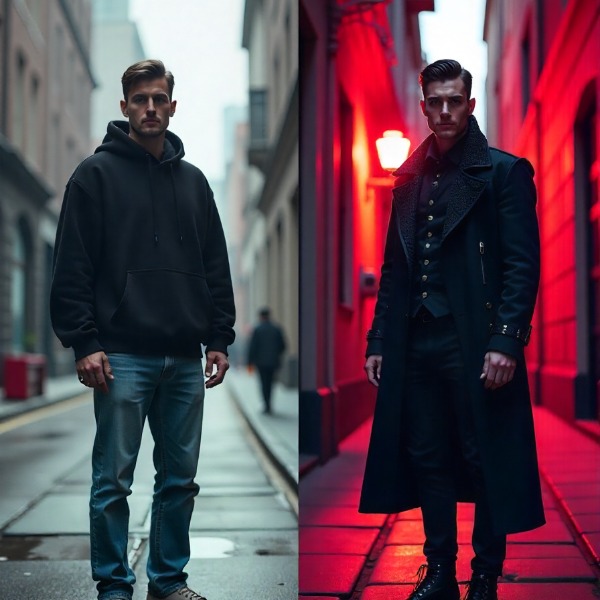
Now, in the post-normcore landscape of 2025, we are witnessing a powerful rebound. The very sameness that once felt refreshing has sparked a new kind of ennui, fueling a widespread demand for the rebellious style that goth so perfectly embodies. On a personal level, I’ve found that even a small act, like adding a Victorian brocade tie to an otherwise simple work shirt, completely shifts the energy of a room and my own sense of confidence. This renewed hunger for expression is why men's gothic fashion isn't just a fleeting trend; it's a powerful canvas for personal storytelling in an age that desperately needs it.
Key Takeaway: Normcore streamlined fashion and promoted a "less is more" philosophy, but its prolonged dominance created a cultural vacuum that the expressive, narrative-rich world of gothic menswear is now perfectly positioned to fill.
The Enduring Roots of Men's Gothic Clothing
To appreciate the future of goth, one must respect its deep and tangled roots. The aesthetic we know today is a rich tapestry woven from centuries of art, literature, and social upheaval. Its origins stretch back to the medieval Gothic period, where the architecture’s soaring, elongated forms and dramatic intensity first inspired the slim, imposing silhouettes that still define the style today.
However, it was the Victorian era (1837-1901) that truly laid the groundwork for Victorian gothic menswear. The period's strict mourning codes normalized the wearing of head-to-toe black, while garments like the frock coat, tailored waistcoats, and top hats established a formal, somber, and romantic uniform. This historical foundation provides the blueprint for many of the elegant, tailored pieces we see in modern collections.
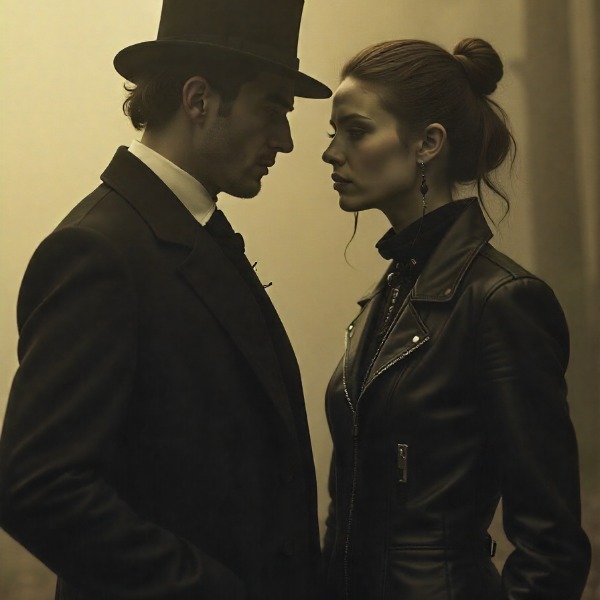
The modern subculture ignited in the late 1970s, born from the ashes of punk. As punk’s explosive anger cooled, it morphed into the more introspective, artistic melancholy of post-punk. Bands like Bauhaus, Siouxsie and the Banshees, and The Cure created a soundscape of driving basslines and shadowy lyrics, and the fashion followed suit. Figures like Peter Murphy of Bauhaus became style icons, pairing slim black suits with a distinctly vampiric flair. The legendary Batcave club in 1980s London cemented this look, fostering a community where vintage finds, DIY alterations, and androgynous makeup became the standard. This legacy is what gives men's gothic fashion its authentic, rebellious spirit, and you can see echoes of it in our collection of gothic coats.
Key Takeaway: Understanding the origins of gothic style—from medieval architecture and Victorian mourning rituals to the 80s post-punk scene—allows you to consciously blend these historical elements into a unique and deeply personal modern look.
The Current State of Gothic Menswear in 2025
Fast forward to 2025, and men's gothic clothing has evolved from a niche subculture to a powerful force influencing mainstream fashion. High-fashion designers are increasingly incorporating dark, romantic lines and bold, alternative accessories into their collections, a clear sign of the aesthetic's growing appeal. Market data supports this observation: the global menswear market, valued at nearly $600 billion in 2024, is projected to surge past $900 billion by 2033, with alternative and niche segments experiencing significant expansion.
Today's most popular items include versatile staples like leather gothic pants, sturdy gothic boots, and shirts bearing occult or band symbols—pieces that are surprisingly adaptable for everyday life. Retailers like The Dark Attitude are at the forefront, championing unisex designs and pushing the boundaries of what dark gothic clothing can be. This visibility is further amplified by popular media, where series like Wednesday or Interview with the Vampire have sparked renewed interest in the aesthetic.
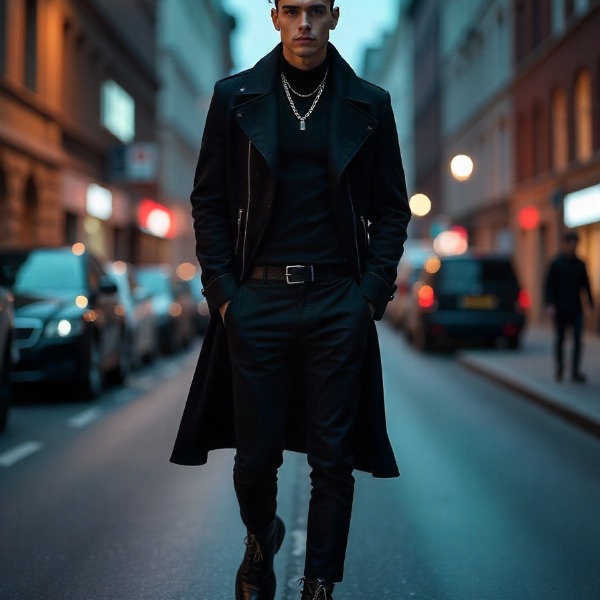
One of the most exciting developments is the rise of Eco-goth or sustainable dark fashion. With growing environmental consciousness, brands are increasingly using recycled materials and ethical production methods. As Vogue recently noted in an article on menswear futures, there's a trend towards "everyday opulence," where men invest in high-quality, long-lasting pieces rather than disposable fast fashion. This philosophy aligns perfectly with goth's inherent appreciation for durable, meaningful garments. The community spirit remains strong, with online forums and social media groups democratizing style tips and fostering a welcoming, inclusive environment for newcomers.
Key Takeaway: Modern gothic menswear is more accessible, sustainable, and diverse than ever. Its growing presence in mainstream culture provides the perfect opportunity to embrace a darker aesthetic with confidence.
Emerging Trends: The Hybrid Future of Post-Normcore Gothic Fashion
The post-normcore world is all about the hybrid. The most exciting trends in men's gothic clothing for 2025 and beyond are born from the fusion of seemingly disparate styles, creating new and dynamic archetypes. Gone are the days of rigid subcultural uniforms; today's dark fashion is modular and open to interpretation.
Two of the most powerful emerging hybrids are:
- Tactical Punk: This trend merges the raw, DIY energy of punk with the functional, utilitarian aesthetic of modern techwear. Think oversized, spiked coats paired with baggy, muted trousers and tactical vests with multiple straps and pockets. It’s a look that feels both rebellious and prepared, perfect for navigating a chaotic urban landscape. Our tactical goth lineup is heavily inspired by this gritty, functional aesthetic.
- Victorian Cyber Goth: At the intersection of past and future, this style combines the romantic elegance of Victorian fashion with the futuristic elements of cyber goth fashion. Imagine a tailored velvet suit augmented with subtle LED trim, or a classic frock coat made from upcycled, high-tech fabrics. It’s a sophisticated and imaginative style that honors history while looking firmly toward the future, especially relevant in the steampunk men's clothing scene.
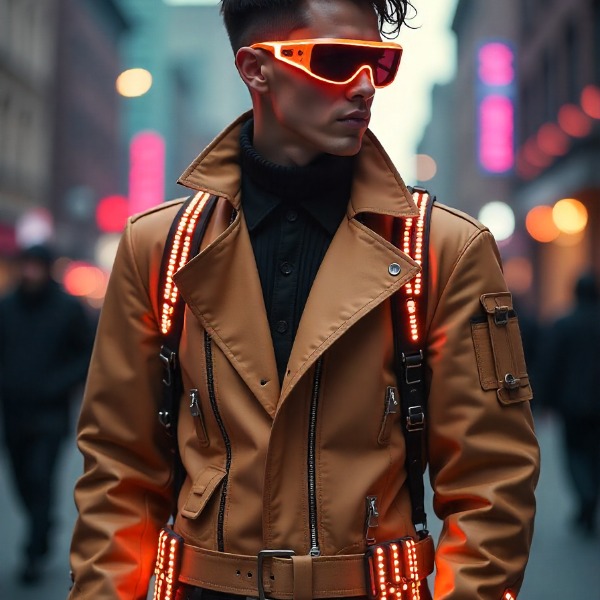
This hybrid approach allows for incredible versatility. The pros are clear: a single garment can be styled in multiple ways, adapting to different moods and occasions. The main con can be the cost, as many of these innovative pieces come from independent designers who prioritize quality and craftsmanship. However, the investment often pays off in a unique, long-lasting garment that makes a powerful statement.
Key Takeaway: The future of gothic menswear lies in hybrids. By blending elements like tactical punk, Victorian elegance, and cyber goth tech, you can create a fresh, dynamic, and deeply personal style that defies easy categorization.
How to Incorporate Gothic Elements into Your Modern Wardrobe
Embracing a darker aesthetic doesn't require an overnight transformation. The most successful approach is gradual, allowing you to integrate pieces thoughtfully and authentically.
- Step 1: Start with a Single Statement Piece. Don't overhaul your entire closet at once. Begin by introducing one key item, like a dramatic men's gothic clothing overcoat or a pair of high-quality [gothic boots], into your existing wardrobe. Wear it with your favorite jeans and a simple t-shirt to see how it feels.
- Step 2: Focus on Foundation and Texture. Once you're comfortable, acquire a few fundamentals. A pair of well-fitting leather gothic pants or a shirt with subtle romantic details can serve as a new base. Then, begin playing with texture—layering a smooth silk shirt under a rough wool jacket, or pairing distressed denim with a velvet blazer.
- Step 3: Accessorize with Intention. Accessories are the easiest way to inject gothic flair. A few well-chosen silver rings, a leather cuff, or a pendant with occult symbolism can instantly elevate a simple outfit. These small details are perfect for testing the waters, especially in a professional setting.
- Step 4: Experiment with Subtle Makeup. For those feeling more adventurous, a touch of faint black eyeliner (often called "guyliner") can add a dramatic edge without being overwhelming. Start small and see what gives you confidence.
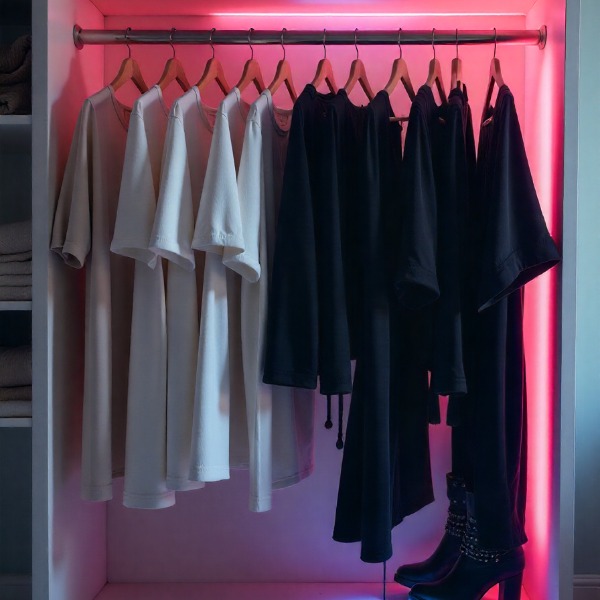
For newcomers, thrifting and exploring secondhand markets can be a fantastic, budget-friendly way to find unique pieces and experiment with differentem without a major financial commitment.
Key Takeaway: Integrating gothic style is a journey, not a race. Start with one key piece, focus on texture and accessories, and build your confidence gradually to create an authentic and edgy wardrobe.
The Pros and Cons of Embracing the Gothic Style
Adopting a distinct aesthetic like gothic menswear is a rewarding journey, but it’s wise to approach it with a balanced perspective.
The Pros:
- Powerful Self-Expression: At its core, this style is a vehicle for showcasing your unique personality, building confidence, and communicating your identity without saying a word.
- A Strong Sense of Community: The goth subculture is a vibrant global community. Embracing the style connects you to a network of like-minded individuals through online forums, festivals, and local meetups.
- Timeless Longevity: Unlike fast-fashion trends that die out in a season, the core elements of gothic style are timeless. A well-made leather jacket or a pair of classic boots will remain stylish for decades, making it a cost-effective choice in the long run.
- Incredible Versatility: As we've seen, modern goth is highly adaptable. It can be blended with countless other styles to create looks that are uniquely your own.
The Cons:
- Public Perception: In highly conservative environments or traditional workplaces, a bold gothic look can still be met with judgment or misunderstanding.
- Financial Investment: High-quality, well-crafted men's gothic clothing can be expensive. Pieces made from genuine leather, wool, and intricate hardware are an investment.
- Maintenance: Dark fabrics, especially black, are prone to showing lint and fading. Delicate materials like velvet and lace, and leather goods, require special care and conditioning.
For me, and for many others, the profound sense of authenticity and empowerment far outweighs the potential drawbacks. It's a choice between the quiet comfort of normcore and the thrilling vitality of self-expression.
Conclusion: A Bold New Era for Dark Expression
As the minimalist tide of normcore recedes, the horizon for men's gothic clothing beckons not with a retreat into the shadows, but with a confident command of them. This is more than a fashion revival; it's a cultural renaissance. It's an invitation to embrace theater, to value history, and to wield audacity as a tool of self-creation. The future of gothic menswear is modular, intelligent, and deeply personal. It offers a rich vocabulary for those who felt voiceless in the era of sameness. So, venture into the dusk—the glow of authentic expression awaits.
Frequently Asked Questions (FAQ)
1. What truly defines men's gothic clothing?
Men's gothic clothing is an aesthetic characterized by dark, romantic, and rebellious looks. It draws from Victorian and punk roots, heavily featuring black fabrics, leather, and intricate details like buckles, straps, and lace to create an enigmatic and expressive appeal.
2. How is post-normcore fashion shaping gothic menswear?
The post-normcore era is moving away from bland uniformity towards vivid self-expression. This allows gothic menswear to flourish, fusing its inherent intensity with the relaxed ease of modern life, leading to innovative hybrids like tactical punk and sophisticated dark academia.
3. What are the essential starter pieces for a gothic wardrobe?
A great starting point includes three core items: a versatile gothic coat, a pair of leather gothic pants (or high-quality black denim), and a sturdy pair of gothic boots. From there, you can gradually build out your collection with shirts and accessories.
4. Can men's gothic fashion be worn in a professional setting?
Absolutely. By focusing on tailored silhouettes and high-quality fabrics, you can create a "corporate goth" look. A well-fitted black blazer, a dark dress shirt, and subtle silver accessories can project an image of creative authority that is both edgy and professional.
5. What are the key gothic apparel trends for men in 2025?
The biggest trends are hybrids: tactical punk (blending utility with rebellion), cyber goth (fusing tech with dark aesthetics), and a rise in sustainable dark gothic clothing. Melds of Victorian elegance with modern streetwear are also very prominent.
6. How can I style gothic elements without looking over-the-top?
The key is balance. Pair one statement piece, like a punk goth style jacket, with neutral basics like a plain tee and dark jeans. This creates a focal point and allows the rebellious detail to shine without overwhelming the entire outfit.
7. Are there budget-friendly ways to build a men's gothic wardrobe?
Definitely. Thrifting and visiting vintage stores are excellent ways to find unique pieces. Exploring online marketplaces can uncover cheap alternative men's fashion, and embracing a DIY attitude by adding studs or patches to existing clothes is a classic, cost-effective method.
8. What are the cultural foundations of modern gothic menswear?
Modern gothic menswear stands on the shoulders of diverse cultural movements. It pulls from the somber elegance of Victorian mourning wear, the raw energy of 80s post-punk music, literary romanticism, and classic horror cinema to create its timelessly shadowy and emotive aesthetic.
